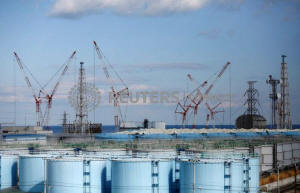|
Fukushima contaminants found as far north
as Alaska's Bering Strait
 Send a link to a friend
Send a link to a friend
 [March 28, 2019]
By Yereth Rosen [March 28, 2019]
By Yereth Rosen
ANCHORAGE, Alaska (Reuters) - Radioactive
contamination from Japan's Fukushima Daiichi nuclear power plant hit by
a tsunami in 2011 has drifted as far north as waters off a remote Alaska
island in the Bering Strait, scientists said on Wednesday.
Analysis of seawater collected last year near St. Lawrence Island
revealed a slight elevation in levels of radioactive cesium-137
attributable to the Fukushima disaster, the University of Alaska
Fairbanks Sea Grant program said.
"This is the northern edge of the plume," said Gay Sheffield, a Sea
Grant marine advisory agent based in the Bering Sea town of Nome,
Alaska.
The newly detected Fukushima radiation was minute. The level of
cesium-137, a byproduct of nuclear fission, in seawater was just
four-tenths as high as traces of the isotope naturally found in the
Pacific Ocean.
Those levels are far too low to pose a health concern, an important
point for people living on the Bering Sea coast who subsist on food
caught in the ocean, Sheffield said.

Cesium-137 levels some 3,000-times higher than those found in the Bering
Sea are considered safe for human consumption under U.S. Environmental
Protection Agency drinking water standards, officials said.
A 9.0-magnitude quake and tsunami in March 2011 triggered meltdowns at
three of the Fukushima Daiichi plant's six reactors, spewing radiation
into the air, soil and ocean and forcing 160,000 residents to flee.
It was the world's worst nuclear disaster since Chernobyl 25 years
earlier.
LONG-TERM STUDY
The results reported on Wednesday came from a long-term but small-scale
testing program.
Water was sampled for several years by Eddie Ungott, a resident of
Gambell village on the northwestern tip of St. Lawrence Island. The
island, though part of the state of Alaska, is physically closer to
Russia than to the Alaska mainland, and residents are mostly Siberian
Yupik with relatives in Russia.
[to top of second column]
|

The reactor units No.1 to 4 are seen over storage tanks for
radioactive water at Tokyo Electric Power Co's (TEPCO)
tsunami-crippled Fukushima Daiichi nuclear power plant in Okuma
town, Fukushima prefecture, Japan February 18, 2019. Picture taken
February 18, 2019. REUTERS/Issei Kato

Fukushima-linked radionuclides have been found as far away as
Pacific waters off the U.S. West Coast, British Columbia and in the
Gulf of Alaska.
Until the most recent St. Lawrence Island sample was tested by the
Woods Hole Oceanographic Institution, the only other known sign of
Fukushima radiation in the Bering Sea was detected in 2014 by the
National Oceanic and Atmospheric Administration.
NOAA scientists found trace amounts of Fukushima-linked
radionuclides in muscle tissue of fur seals on Alaska's St. Paul
Island in the southern Bering Sea. There was no testing of the water
there, Sheffield said.
The people of St. Lawrence Island, who live well to the north of St.
Paul Island, had expected Fukushima radionuclides to arrive
eventually, she said.
"They fully anticipated getting it. They didn't know when," she
said. "The way the currents work does bring the water up from the
south."
(Reporting by Yereth Rosen in Anchorage; Editing by Steve Gorman and
Darren Schuettler)
[© 2019 Thomson Reuters. All rights
reserved.]
Copyright 2019 Reuters. All rights reserved. This material may not be published,
broadcast, rewritten or redistributed.
Thompson Reuters is solely responsible for this content.
 |